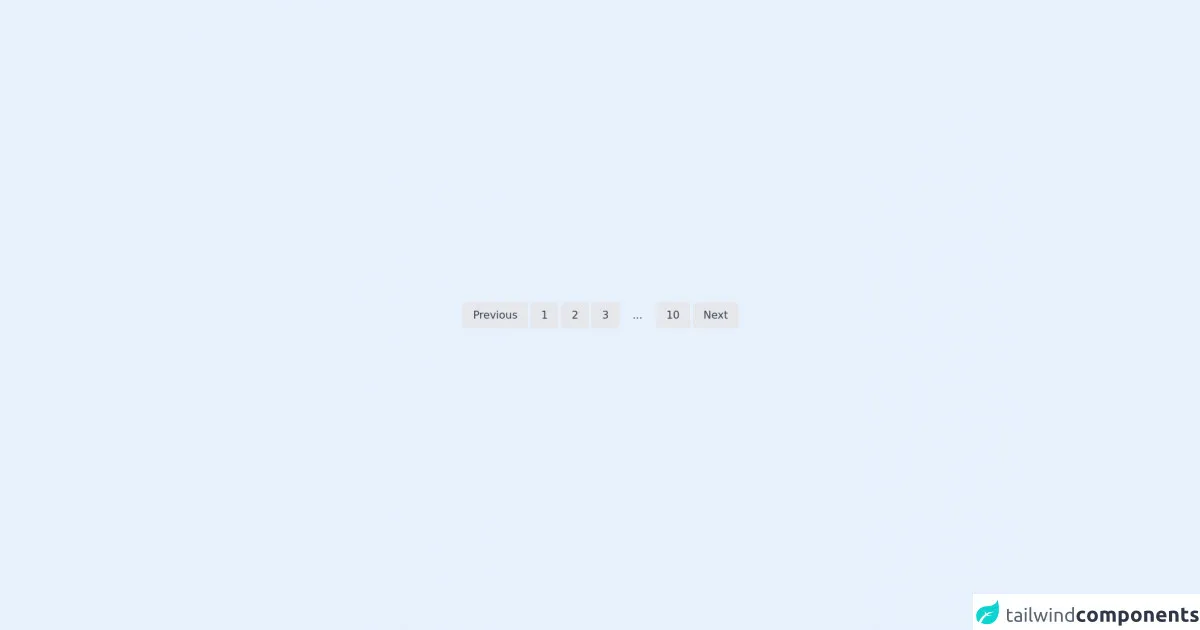- Published on
How to Make A Pagination With Tailwind CSS?

- What is Tailwind CSS?
- The description of Pagination ui component
- Why use Tailwind CSS to create a Pagination ui component?
- The preview of Pagination ui component
- The source code of Pagination ui component
- How to create a Pagination with Tailwind CSS?
- Conclusion
What is Tailwind CSS?
Tailwind CSS is a utility-first CSS framework that allows you to create custom designs without writing any CSS code. It provides a set of pre-defined classes that you can use to style your HTML elements. With Tailwind CSS, you can create responsive and mobile-first designs quickly and easily.
The description of Pagination ui component
Pagination is a user interface component that allows users to navigate through a large set of data or content. It is commonly used in websites and applications that display a list of items, such as search results, blog posts, or e-commerce products. Pagination typically consists of a series of numbered links that users can click to move to the next or previous page of content.
Why use Tailwind CSS to create a Pagination ui component?
Tailwind CSS provides a set of pre-defined classes that you can use to create a Pagination ui component quickly and easily. With Tailwind CSS, you can customize the look and feel of your Pagination component without having to write any CSS code. This saves you time and effort and allows you to focus on the functionality of your component.
The preview of Pagination ui component
To create a Pagination ui component with Tailwind CSS, you can use the following classes:
.pagination: This is the main container for the Pagination component..page-item: This class is used to style each individual page link..page-link: This class is used to style the link text inside each page link..active: This class is used to style the current active page link.
Free download of the Pagination's source code
The source code of Pagination ui component
To create a Pagination ui component with Tailwind CSS, you can use the following HTML code:
<nav class="pagination">
<ul class="flex">
<li class="page-item">
<a href="#" class="page-link">1</a>
</li>
<li class="page-item">
<a href="#" class="page-link">2</a>
</li>
<li class="page-item active">
<a href="#" class="page-link">3</a>
</li>
<li class="page-item">
<a href="#" class="page-link">4</a>
</li>
<li class="page-item">
<a href="#" class="page-link">5</a>
</li>
</ul>
</nav>
<div class="flex min-h-screen items-center justify-center bg-zinc-800">
<div class="flex select-none space-x-1 text-gray-700">
<a href="#" class="rounded-md bg-gray-200 px-4 py-2 transition duration-300 hover:bg-gray-400"> Previous </a>
<a href="#" class="rounded-md bg-gray-200 px-4 py-2 transition duration-300 hover:bg-gray-400"> 1 </a>
<a href="#" class="rounded-md bg-gray-200 px-4 py-2 transition duration-300 hover:bg-gray-400"> 2 </a>
<a href="#" class="rounded-md bg-gray-200 px-4 py-2 transition duration-300 hover:bg-gray-400"> 3 </a>
<span class="rounded-md px-4 py-2"> ... </span>
<a href="#" class="rounded-md bg-gray-200 px-4 py-2 transition duration-300 hover:bg-gray-400"> 10 </a>
<a href="#" class="rounded-md bg-gray-200 px-4 py-2 transition duration-300 hover:bg-gray-400"> Next </a>
</div>
</div>
How to create a Pagination with Tailwind CSS?
To create a Pagination ui component with Tailwind CSS, you can follow these steps:
- Create a new HTML file and add the following code:
<!DOCTYPE html>
<html lang="en">
<head>
<meta charset="UTF-8">
<title>Pagination with Tailwind CSS</title>
<link rel="stylesheet" href="https://cdn.jsdelivr.net/npm/[email protected]/dist/tailwind.min.css">
</head>
<body>
<nav class="pagination">
<ul class="flex">
<li class="page-item">
<a href="#" class="page-link">1</a>
</li>
<li class="page-item">
<a href="#" class="page-link">2</a>
</li>
<li class="page-item active">
<a href="#" class="page-link">3</a>
</li>
<li class="page-item">
<a href="#" class="page-link">4</a>
</li>
<li class="page-item">
<a href="#" class="page-link">5</a>
</li>
</ul>
</nav>
</body>
</html>
- Save the file as
index.html. - Open the file in your web browser to see the Pagination ui component.
Conclusion
In this article, we have learned how to create a Pagination ui component with Tailwind CSS. Tailwind CSS provides a set of pre-defined classes that you can use to create custom designs quickly and easily. With Tailwind CSS, you can focus on the functionality of your component without having to write any CSS code. By following the steps outlined in this article, you can create a Pagination ui component that is both functional and visually appealing.